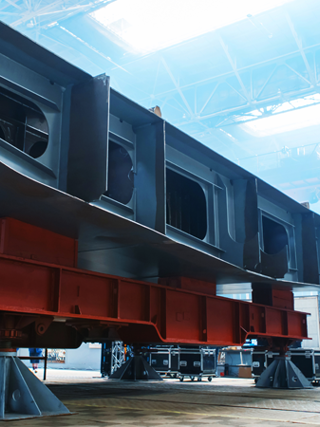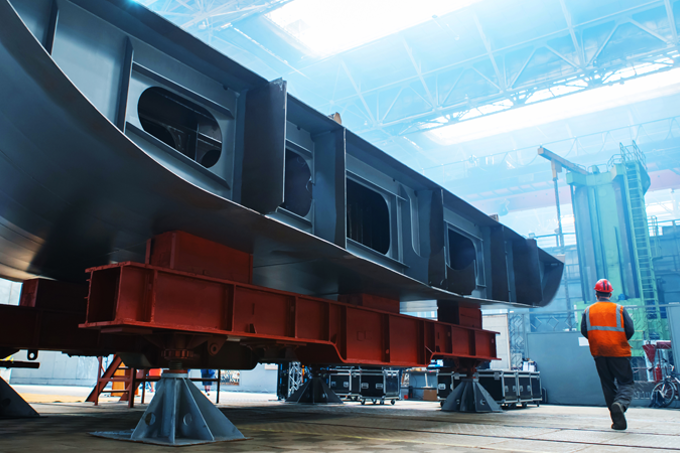The new construction landscape is changing fast. LR is working with shipyards and designers to develop the next generation of vessel designs, including new ship types, size ranges, and technologies.
Jas Foo, Lloyd’s Register’s New Construction Marketing Manager, assesses the potential for digital technology to completely transform the global shipbuilding industry.
Digital systems, autonomous operations, and smart software offer scope to transform most industrial sectors, like the automobile industry for example. But shipping generally lags, and shipbuilding is even further behind the curve due to the various risks involved. Should this continue, the traditional shipping industry may be unable to keep up with the increasing competition from disruptive new players who use digital technology to suit ever-increasing demands on shipbuilding and design. So, where should we focus our efforts to expedite a new digital era in global shipbuilding?
Although API-based data-sharing is now widely used to raise productivity and boost sustainability across most industrial sectors, it is still uncommon in maritime. The shipbuilding value chain may be empowered to make better decisions and deliver smarter assets by sharing and integrating data from the influx of new artificial intelligence (AI) and machine learning (ML) based technologies that are now becoming evident in both shipbuilding and operational sectors.
Some in the sector see digital technologies as disruptive but, in my opinion, this is only because they have not yet had an opportunity to understand the benefits that such technology can yield. Through technology, there is enormous potential to use data in new ways to facilitate better decision-making or to solve complex problems. Those who are brave enough to embrace it will reap the benefits in ship design and construction – and those who subsequently operate ships through life.
Benefits of digitalising shipbuilding
The impact of digitalisation happens at the very beginning of a ship’s lifecycle. The real benefit comes when the use of data is considered at the conceptual stage of ship design.
Of course, there are many barriers. Legacy systems in many shipyards would need to be modernised or integrated; and as any company that has switched to a new system will know, there are inherent risks to a system-wide change. This is even more critical in an industry that operates with tight deadlines and slim margins. With careful planning and implementation, technology, automated processes, and big data can revolutionise long-established working practices, enhancing efficiency, productivity, profitability, reliability, quality, predictive improvement, and one that is often overlooked – shipbuilding’s manpower scarcity.
On a broader level, data sharing through digital systems benefits all parties in the supply chain. Everyone, from ship designers to builders, equipment manufacturers and raw material suppliers to ship managers and maintenance yards, may gain from these digital records. Any changes or updates to ship design, data, or project management are communicated via integrated data sharing, possibly through a centralised location accessible to all stakeholders. These traceable processes are the key to achieving efficiency and avoiding miscommunication. This does not imply that people will be replaced by machines or computers, but rather they will be able to focus on other tasks. With increased data-sharing comes the risk of cyber-attacks and data breaches. It is evident that businesses of any size or location are vulnerable to such cyber-attacks. As data usage grows, so does the need for all stakeholders to address the need for a robust cyber security technology.
Ship builders are leveraging data-driven technology to drive business innovation and become more efficient in this highly competitive market. Standard processes, such as cutting, welding, blasting, and painting, lend themselves naturally to autonomous operations. Indeed, such systems are considered standard to streamline workflows and lower the likelihood of any potential errors. Digital twin technology is increasingly being recognised as a driving force in identifying any potential future hazards in ship design and construction, and operation systems, thereby enhancing operational efficiency, safety, and sustainability.
Ships must be built smarter, combining all the technology that makes them more sustainable and compliant with decarbonisation and greenhouse gas regulations throughout their trading lifecycle.
5G connectivity in shipbuilding
Digital processes will support shipbuilders to adapt to impending regulatory and customer requirements as they have the potential for improved production systems, better shipbuilding productivity, integration of design innovation with manufacturing processes, in-service upgrades, and monitoring of new technology within newbuild, all of which promote modernisation and optimisation in shipbuilding.
Machine learning, virtual and augmented reality, and artificial intelligence are among the cutting-edge technologies being used by some of the industry’s leading innovators. The scalable, flexible and low-latency 5G network available today, when deployed within the shipyards, can greatly benefit the automated processes by driving better collaboration and efficiency with real-time feedback. Shipyard workers could visualise and identify design nonconformities using AR glasses that overlay on the actual ship structure that is being constructed. This enables immediate corrections and eliminates time-consuming rework that would otherwise be necessary. This is especially useful as ship design becomes more complex. Also, sensors in machines such as cranes and welding devices in a digital shipyard use real-time data analytics to detect deviations and recommend corrective actions in the event of an anomaly. This saves resources, improves quality, and speeds up construction by reducing or eliminating re-work.
With the advancement of 5G technology, shipbuilding should become faster and more efficient whilst still meeting and potentially improving build quality standards.
Collaboration to drive a better shipbuilding process
Those charged with developing and deploying smart digital systems for improved productivity and quality, will likely support a smaller workforce traditionally engaged in standard, repetitive, and often tedious tasks. Task and responsibilities in the workplace will also shift. Technology interaction becomes part of the daily routine, and determines what we do, how we do it, and where we do it.
Assets will be built to a higher quality, and delivered to shipowners with a predictive maintenance plan in place. These assets will also have to be ‘future-proofed’. With 5G technology, data transfer across construction departments becomes seamless, allowing for a modularised shipbuilding process. A virtual image of the ship and its respective build section is made visible, and widely available. Ship blocks or sections can be taken out and replaced during build and across ships’ lives such as building a ship with replaceable bunker tanks to meet the challenges of the fuel transition.
Ships built with ‘modernisation’ in mind will be adapted to operate on low- or zero-carbon fuels with lower energy densities, as well as new fuel storage and supply systems, not to mention the ease to add new operational efficiency technologies or design modification later through the virtual design.
What’s next
Building a ship is a complicated process, let alone doing so in a more efficient manner. Engaging a smart shipyard that could build a ship that meets the current digital and regulatory requirements is a challenge.
To capitalise on the benefits through life, owners should consider the opportunities that a digitalised design and construction will give them over the life of the vessel. New ships must build with a virtual ‘birth certificate’ that contains all the necessary data to facilitate future S&P transactions. This drives the development of specifications and ultimately evolutionary or even revolutionary design stages to meet their demands. To highlight again, the impact of digitalisation happens at the very beginning of a ship's lifecycle.
At the same time, as the industry's cyclical market continues to offer boom or bust fortunes for many yards. Adopting the technologies highlighted during a booming market may offer protection in leaner times ahead, ensuring that the production efficiencies and design advances can provide a win-win situation for both yards and owners to build the decarbonised vessels we need.
At LR, we can assist you in bringing about the desired transformation and help you get closer to your goal of building a more efficient ship.








